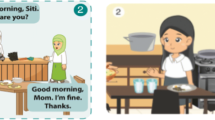Abstract
Gender stereotyping has long been an issue for gender and language research from as early as the 1970s, and analyses on gender representation in English language textbooks have been frequently conducted. However, gender representation in assessment papers, another commonly occurring genre in education, remains unexplored in Hong Kong research. Therefore, this paper was aimed to explore how males and females are represented in Territory-wide System Assessment (TSA), a territory-level assessment administered in Hong Kong, to find out if gender stereotyping is still an issue. The data of the current study include the recent 10 years of TSA Primary 3 English Language Reading & Writing papers. A total of 33 sets of TSA Primary 3 English Language Reading & Writing papers was analysed by using content and linguistic analyses for their written texts and visual analysis for visual elements. The key findings include: males and females are represented similarly in the written texts and in the visuals, and females are portrayed as involving in occupational roles more frequently than males in both the written texts and visuals. However, it is always females who were drawn to be focused on family matters, and the marital status of a female is still distinguished by the use of either Miss or Mrs. Suggestions for test paper designers and examination authorities are given and implications for future research studies are drawn at the end of this paper.







Similar content being viewed by others
Notes
The term ‘tokens’ refers to the total number of words no matter how many times they are repeated in a piece of text. However, the term ‘types’ refers to the different words in the text (Scott, 2010).
References
Ariyanto, S. (2018). A portrait of gender bias in the prescribed Indonesian ELT textbook for junior high school students. Sexuality and Culture,22, 1054–1076.
Bandura, A. (1977). Social learning theory. Englewood Cliffs, NJ: Prentice-Hall.
Basow, S. A. (1992). Gender: Stereotypes and roles (3rd ed.). Pacific Grove: Brooks/Cole Publishing Company.
Bourdieu, P. (1991). Language and symbolic power. Cambridge, MA: Harvard University Press.
Bourdieu, P., & Passeron, J. C. (1990). Reproduction in education, society and culture. London: Sage.
Carless, D. (2010). Classroom assessment in the Hong Kong policy context. In B. McGaw, E. Baker, & P. Peterson (Eds.), International encyclopedia of education (3rd ed., pp. 438–442). Oxford: Elsevier.
Census and Statistics Department. (2018). Women and men in Hong Kong: Key statistics (2018 edn). Hong Kong: Census and Statistics Department.
Centre for English Language Education. (2001). Stereotypes in textbooks and teaching materials in Hong Kong. Retrieved July 12, 2019, from https://www.hurights.or.jp/archives/pdf/asia-s-ed/v06/11Hongkong.pdf
Cherland, M. R. (1994). Private practices: Girls reading fiction and constructing identity. London: Taylor & Francis.
Clark, R. (2002). Why all the counting? Feminist social science research on children’s literature. Children’s Literature in Education,33(4), 285–295.
Dahmardeh, M., & Kim, S. (2019). Gender representation in Iranian English language coursebooks: Is sexism still alive. English Today. https://doi.org/10.1017/S0266078419000117
Deng, C., & Carless, D. (2010). Examination preparation or effective teaching: conflicting priorities in the implementation of a pedagogic innovation. Language Assessment Quarterly,7(4), 285–302.
Eckert, P., & McConnell-Ginet, S. (2013). Language and gender. Cambridge: Cambridge University Press.
Equal Opportunities Commission. (1997). A baseline survey of equal opportunities on the basis of gender in Hong Kong: 1996–1997. Hong Kong: Equal Opportunities Commission.
Equal Opportunities Commission. (n.d.). Equal Opportunities Commission. Retrieved August 14, 2009, from http://www.eoc.org.hk/EOC/GraphicsFolder/default.aspx#
Etaugh, C. A., & Bridges, J. S. (2010). Women’s lives: A psychological exploration (2nd ed.). Boston: Allyn & Bacon.
Evans, L., & Davies, K. (2000). No sissy boys here: A content analysis of the representation of masculinity in elementary school reading textbooks. Sex Roles,42(3–4), 255–270.
Foucault, M. (1979). Discipline and punish: The birth of the prison. New York: Vintage Books.
Gallagher, M. (2001). Women and gender. In H. Giskin & B. S. Walsh (Eds.), An introduction to Chinese culture through the family (pp. 89–105). Albany, NY: State University of New York Press.
Graddol, D., & Swann, J. (1989). Gender voices. Oxford: Blackwell.
Hanson, F. A. (1993). Testing testing: Social consequences of the examined life. Berkeley, CA: University of California Press.
Hong Kong Examinations and Assessment Authority. (2018). About HKEAA. Retrieved July 13, 2019, from http://www.hkeaa.edu.hk/en/about_hkeaa/
Hong Kong Examinations and Assessment Authority. (2015). Territory-wide System Assessment 2015 (Primary Schools) Quick Guide Part 1. Hong Kong: Hong Kong Examinations and Assessment Authority.
Hong Kong Examinations and Assessment Authority. (n.d.). TSA: Introduction. Retrieved July 5, 2019, from https://www.bca.hkeaa.edu.hk/web/TSA/en/Introduction.html
Hong Kong Professional Teachers’ Union. (2014). Territory-wide System Assessment: Results of Investigation by Questionnaire. Retrieved July 5, 2019, from https://www.hkptu.org/573
Islam, K. M. M., & Asadullah, M. N. (2018). Gender stereotypes and education: A comparative content analysis of Malaysian, Indonesian, Pakistani and Bangladeshi school textbooks. PLoS ONE. https://doi.org/10.1371/journal.pone.0190807.
Lam, R. (2018). Testing, drilling and learning: What purpose does the Grade 3 Territory-wide System Assessment serve? Asia Pacific Education Review,19, 363–374.
Lee, J. F. K. (2014). Gender representation in Hong Kong primary school ELT textbooks—a comparative study. Gender and Education,26(4), 356–376.
Lee, J. F. K. (2018). Gender representation in Japanese EFL textbooks—a corpus study. Gender and Education,30(3), 379–395.
Lee, J. F. K., & Collins, P. (2008). Gender voices in Hong Kong English textbooks—Some past and current practices. Sex Roles,59(1–2), 127–137.
Lindsey, L. L. (2011). Gender roles: A sociological perspective (5th ed.). Boston: Prentice Hall.
Litosseliti, L. (2006). Gender and language: Theory and practice. London: Hodder Arnold.
Manstead, A. S. R., & Hewstone, M. (Eds.). (1995). The Blackwell encyclopedia of social psychology. Oxford: Blackwell.
Miller, C., & Swift, K. (1988). The handbook of nonsexist writing (2nd ed.). New York: Harper & Row.
Pauwels, A. (2003). Linguistic sexism and feminist linguistic activism. In J. Holmes & M. Meyerhoff (Eds.), The handbook of language and gender (pp. 550–570). Malden, MA: Blackwell Publishing.
Scott, M. (2010). Type/token ratios and the standardised type/token ratio. Retrieved July 13, 2019, from https://lexically.net/downloads/version5/HTML/index.html?type_token_ratio_proc.htm
Sunderland, J. (2000). Issues of language and gender in second and foreign language education. Language Teaching,33(4), 203–223.
Sunderland, J. (2004). Gendered discourses. New York: Palgrave Macmillan.
Sunderland, J. (2006). Language and gender: An advanced resource book. London: Routledge.
Sunderland, J. (2011). Language, gender and children’s fiction. New York: Continuum.
Tajeddin, Z., & Enayat, M. J. (2010). Gender representation and stereotyping in ELT textbooks: A critical image analysis. Teaching English Language,4(2), 51–79.
Talbot, M. M. (1998). Language and gender: An introduction. Cambridge: Polity Press.
Willbrand, M. L., & Iwata-Reuyl, G. (1994). Gender bias in language testing. Asha A Journal of the American Speech-Language-Hearing Association,36(11), 50–52.
Winter, R. (2010). Maria diets and Mr. Schmitt does overtime: gender bias in textbooks for learners of Japanese. The Journal and Proceedings of GALE,2010(3), 4–17.
Women’s Commission. (2009). Findings of survey on community perception on gender issues. Retrieved May 7, 2014, from http://www.women.gov.hk/text/en/research_statistics/research_CP_on_gender.htm
Wong, M. (2014). Teacher-student power relations in primary schools in Hong Kong. Lanham: Lexington Books.
Yang, C. C. R. (2011). Gender representation in a Hong Kong primary English textbook series: The relationship between language planning and social policy. Current Issues in Language Planning,12(1), 77–88.
Yang, C. C. R. (2014). Gender representation in Hong Kong primary English language textbooks: A study of two widely-used textbook series. Unpublished PhD thesis, Lancaster University.
Yang, C. C. R. (2016). Are males and females still portrayed stereotypically? Visual analyses of gender in two Hong Kong primary English Language textbook series. Gender and Education,28(5), 674–692.
Zeng, K. (1999). Dragon gate: Competitive examinations and their consequences. London: Cassell.
Author information
Authors and Affiliations
Corresponding author
Ethics declarations
Conflict of interest
The authors declare that they have no conflict of interest.
Ethical approval
This article does not contain any studies involving human participants performed by any of the authors.
Additional information
Publisher's Note
Springer Nature remains neutral with regard to jurisdictional claims in published maps and institutional affiliations.
Rights and permissions
About this article
Cite this article
Yang, C.C.R., Yan, T.L. An Analysis of Gender Representation in Territory-Wide System Assessment English Language Papers for Primary School Students in Hong Kong. Sexuality & Culture 24, 1128–1149 (2020). https://doi.org/10.1007/s12119-020-09754-0
Published:
Issue Date:
DOI: https://doi.org/10.1007/s12119-020-09754-0




